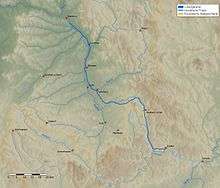Ludwig Canal


The Ludwig Canal (German: Ludwig-Donau-Main-Kanal or Ludwigskanal), is an abandoned canal in southern Germany. It linked the Danube River at Kelheim with the Main River at Bamberg, connecting the Danube basin with the Rhine basin. The canal is named after King Ludwig I of Bavaria, and was built between 1836 and 1846.
The canal had a narrow channel, with many locks, and a shortage of water in the peak section, so the operation of the waterway soon became uneconomic — especially given the rapidly advancing construction of the railway network in the southern German countryside. The canal was finally abandoned in 1950, rather than repair the damage suffered during World War II.
Construction of the roughly parallel, but much larger, Rhine–Main–Danube Canal was started in 1921, but not completed until 1992.
Today
About 60 km of canal, between Nuremberg and Berching, still exists and is in good condition. Some of the locks still function. Part of the tow path has been converted to a bike path.[1]
References
| Wikimedia Commons has media related to Ludwig Canal. |